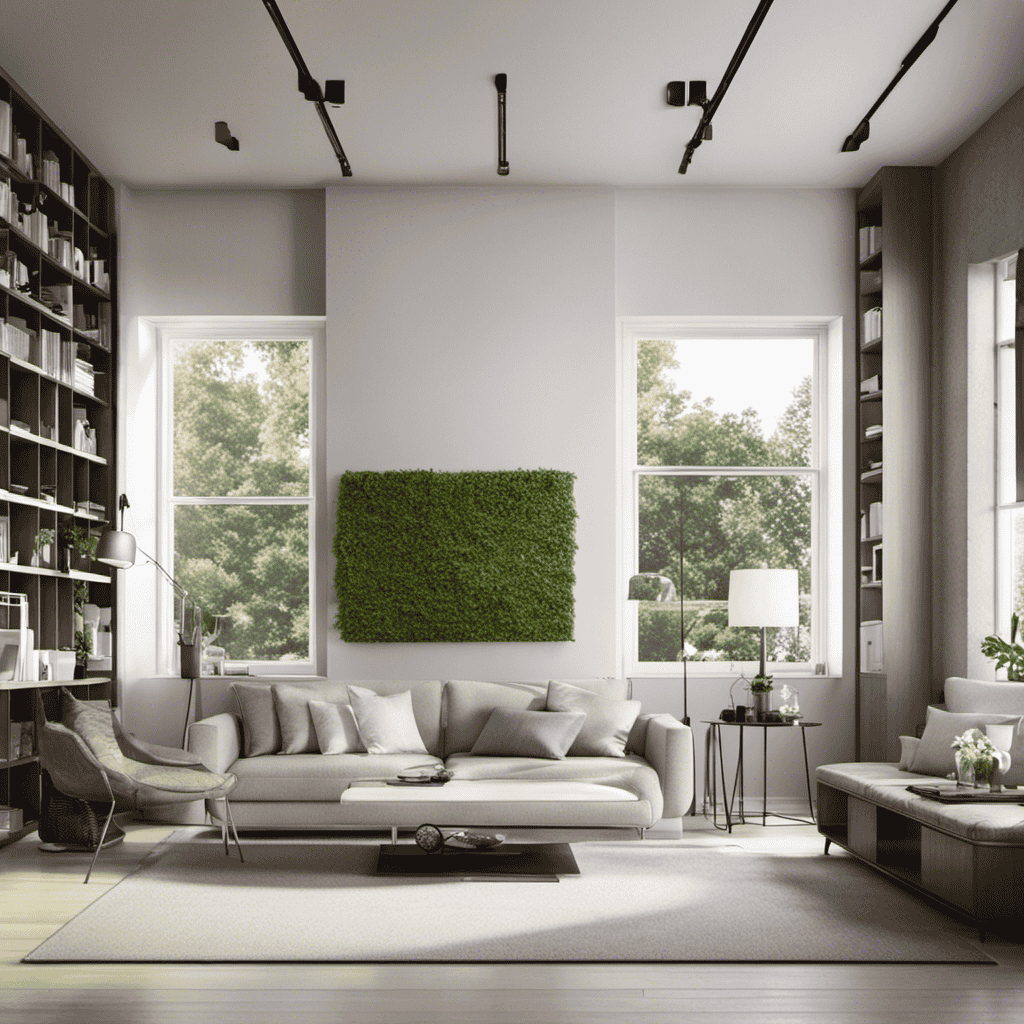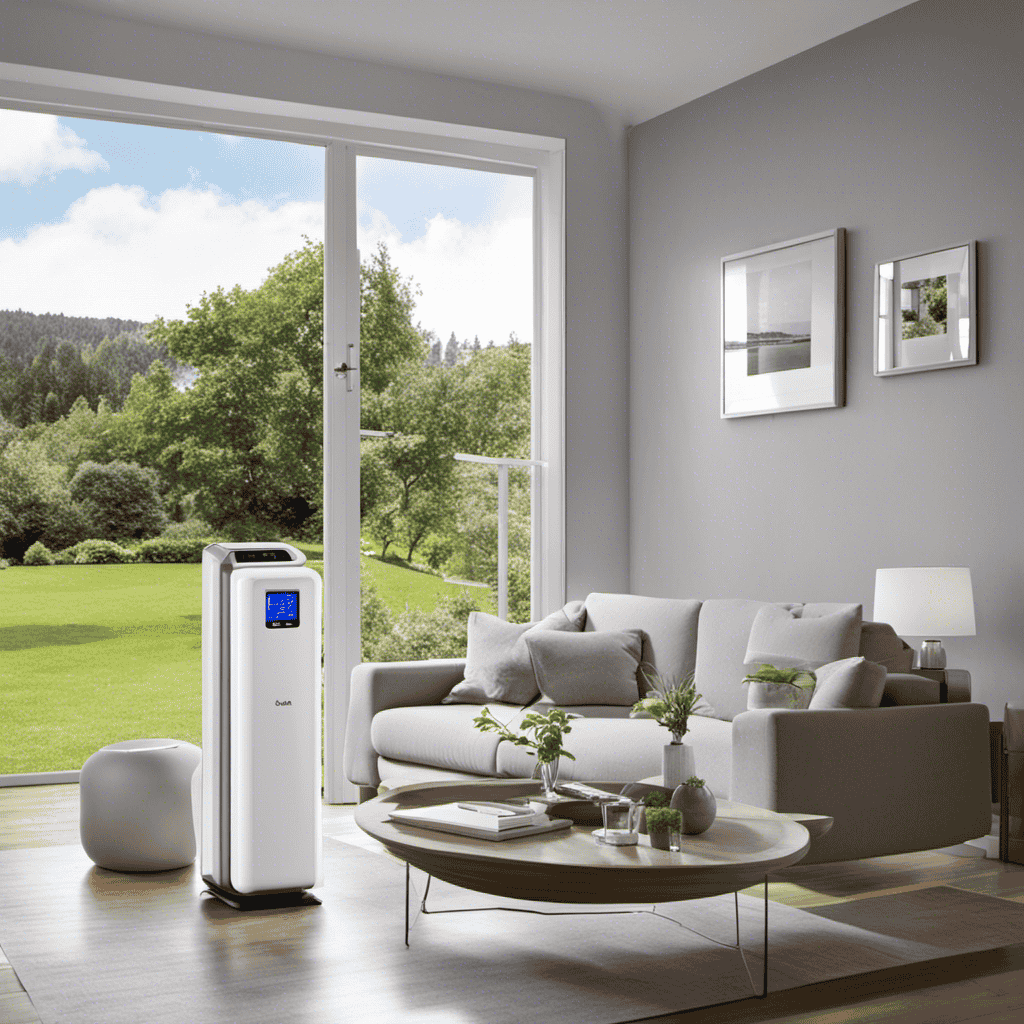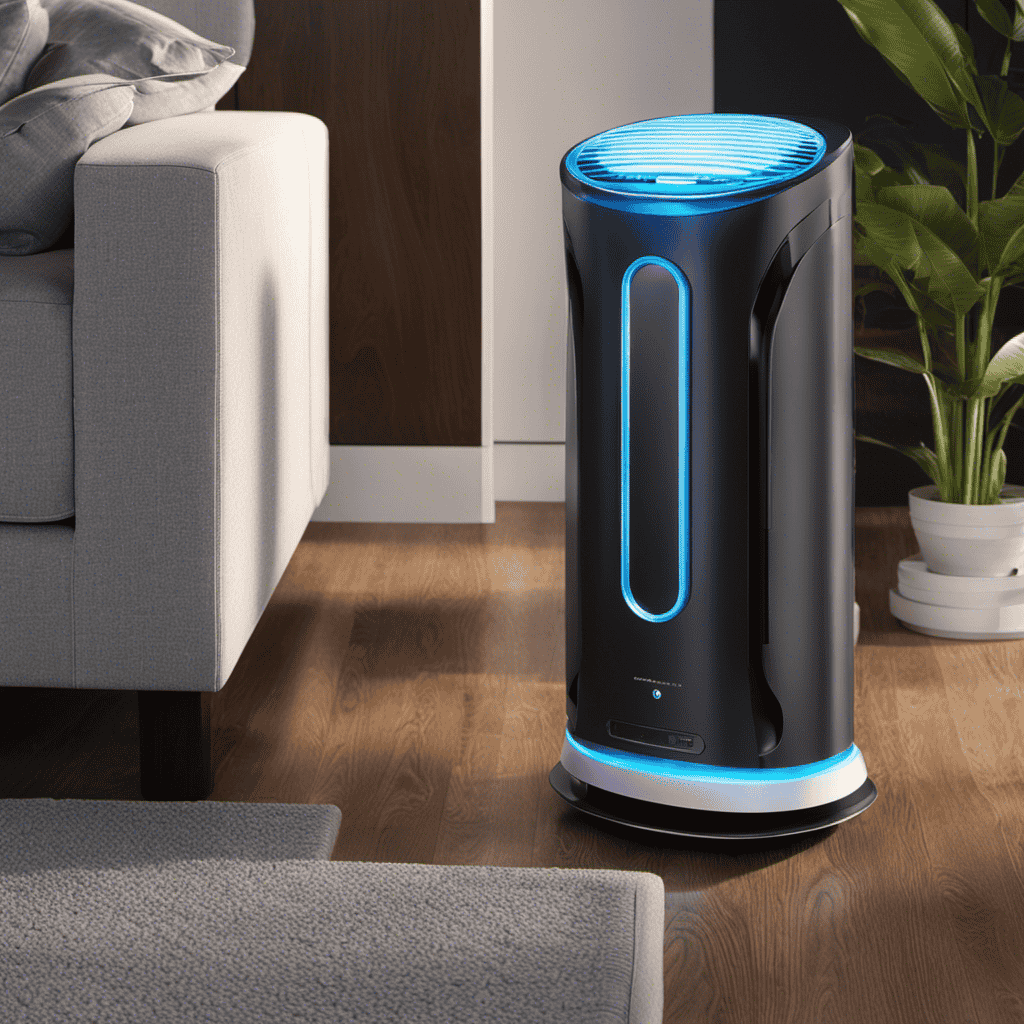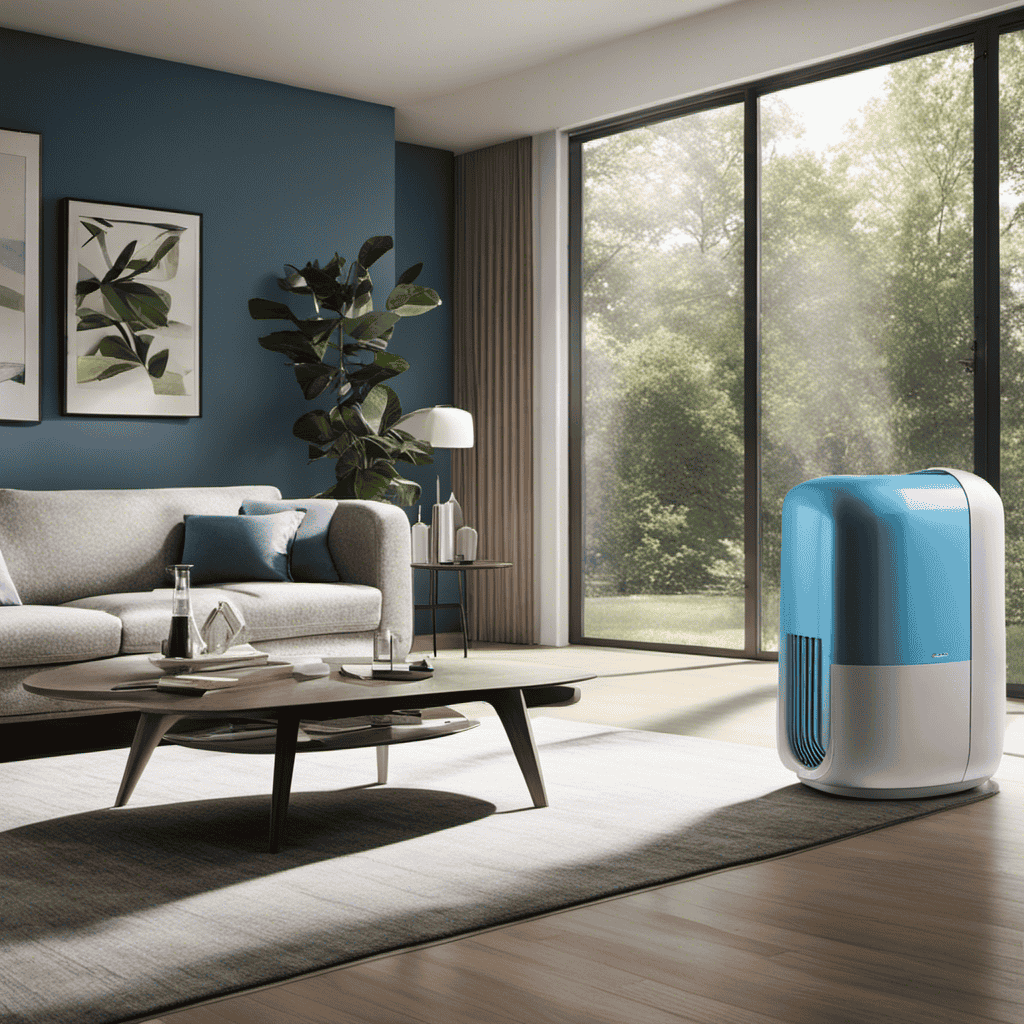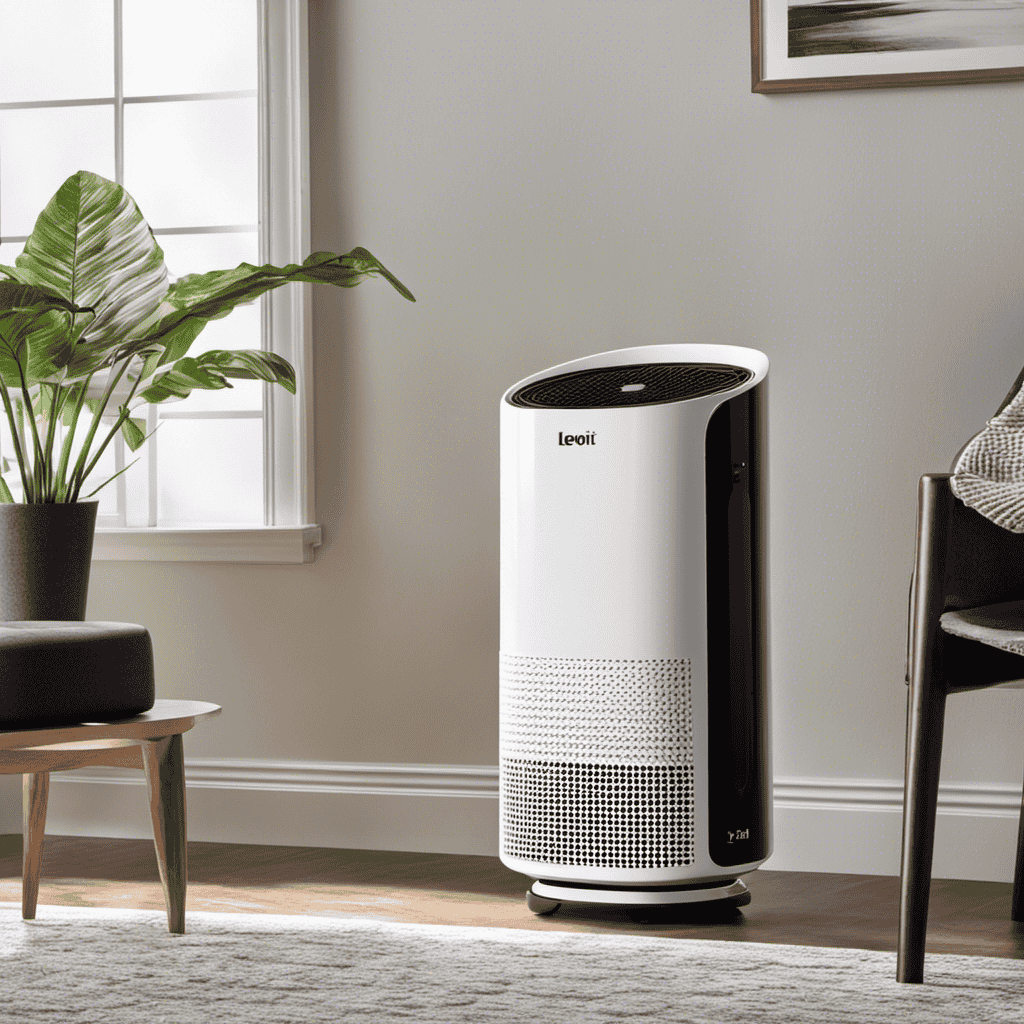When I enter a room, I can’t help but imagine the unseen particles floating in the air, impacting my health. This is why it is important to consider the room size when choosing an air purifier.
In this article, I will guide you through the process, ensuring you understand the importance of room size and how to measure it accurately. By the end, you’ll be equipped with the knowledge to determine the ideal air purifier size for any space, ensuring clean and fresh air for your health and comfort.
Key Takeaways
- Accurate measurements are crucial for determining the effectiveness of an air purifier.
- Proper calculations and measurements ensure the air purifier effectively covers the square footage of the room.
- Break down the space into smaller, manageable shapes when dealing with unconventional room layouts to calculate square footage accurately.
- Consider factors such as air changes per hour, Clean Air Delivery Rate, noise level, and adjustable fan speeds when determining the ideal air purifier size.
Understanding the Importance of Room Size
Understanding the importance of room size is crucial when calculating the square footage for an air purifier. The size of the room directly affects the performance and effectiveness of the air purifier.
There are several factors that can influence the size of a room, such as the number of occupants, furniture placement, and the presence of pets or smokers. These factors can contribute to the accumulation of pollutants and allergens in the air, making it necessary to choose an air purifier with the appropriate square footage coverage.
A room with a larger size will require a more powerful air purifier to effectively clean the air. On the other hand, a smaller room may only need a compact air purifier.
Measuring the Length and Width of the Room
To measure the length and width of the room, follow these steps:
- Begin by selecting a starting point on one wall and extend the measuring tape along the length of the room until you reach the opposite wall. Make sure the tape is straight and parallel to the floor.
- Take note of the measurement in feet and inches. Write it down.
Repeat the process for the width of the room, measuring from one wall to the other. Again, record the measurement in feet and inches.
Calculating the Area of the Room
When it comes to measuring room dimensions accurately, there are a few key points to keep in mind.
Firstly, ensure that you are using the correct tools, such as a tape measure, to obtain precise measurements.
Secondly, be sure to measure all sides of the room, including any alcoves or irregular shapes, to calculate the square footage accurately.
Lastly, it is important to understand the formula for calculating square footage, which involves multiplying the length by the width.
Proper calculations are crucial in determining the correct square footage of a room, especially when it comes to tasks like purchasing flooring or determining the capacity of an air purifier.
Measuring Room Dimensions Accurately
To accurately measure the dimensions of a room, use a tape measure and ensure all corners are accounted for. Here are four steps to measuring room dimensions effectively:
-
Start at one corner of the room and measure the length of one wall. Hold the tape measure straight and tight for accurate results.
-
Move to the next corner and measure the width of the room. Again, keep the tape measure straight and tight.
-
Measure any additional walls in the room, ensuring you capture all dimensions accurately.
-
Finally, double-check your measurements by measuring diagonally across the room from corner to corner. The measurements should be equal if the room is square or rectangular.
It’s important to avoid common mistakes in measuring room size. These include not accounting for corners, not measuring the full length or width, and forgetting to measure diagonally. By following these steps and avoiding common mistakes, you can ensure accurate measurements for your room dimensions.
Calculating Square Footage Formula
Make sure you multiply the length of the room by the width to calculate the square footage accurately. This is the most common and straightforward method of calculating square footage.
To begin, measure the length of one wall and the width of another wall. Ensure that your measurements are in the same unit, such as feet or meters. Once you have both measurements, simply multiply them together.
For example, if the length of the room is 10 feet and the width is 12 feet, the square footage would be 120 square feet.
It’s important to avoid common mistakes in calculating square footage, such as forgetting to convert measurements to the same unit or not including irregularly shaped areas of the room. Taking these precautions will ensure accurate calculations when determining the square footage of a room.
Importance of Proper Calculations
Ensure you’re taking proper measurements to accurately determine the square footage of a room. Proper calculations and accurate measurements are crucial when finding the right square footage for your air purifier. Here are four important points to consider:
-
Use a tape measure: Measure the length and width of the room in feet, making sure to measure from wall to wall. This will give you the basic dimensions of the room.
-
Account for doorways and windows: Subtract the square footage of any doors or windows from the total square footage. This will give you a more accurate measurement of the actual space that needs to be covered.
-
Consider the height: If the room has high ceilings, multiply the length and width by the height to calculate the cubic footage. Some air purifiers are designed to handle larger spaces based on cubic footage, so this measurement is important.
-
Calculate the square footage: Multiply the length by the width to get the square footage of the room. This will help you determine the appropriate size of air purifier needed.
By following these proper calculations and taking accurate measurements, you can ensure that your air purifier effectively covers the square footage of your room.
Now let’s move on to accounting for oddly shaped rooms…
Accounting for Oddly Shaped Rooms
Calculating the square footage of oddly shaped rooms can be a bit more challenging, but it is still possible to get an accurate measurement. When dealing with unconventional room layouts, it is important to break down the space into smaller, more manageable shapes. For example, if your room has a nook or alcove, measure the length and width separately and then calculate the square footage of each shape individually. Once you have the measurements of all the individual shapes, you can simply add them together to get the total square footage of the room. To illustrate this method, here is a table that demonstrates how to calculate the square footage of an oddly shaped room with three different sections:
| Section | Length (ft) | Width (ft) | Square Footage |
|---|---|---|---|
| A | 10 | 8 | 80 |
| B | 6 | 4 | 24 |
| C | 5 | 3 | 15 |
| Total | 119 |
Considering Ceiling Height
When it comes to considering ceiling height, it’s important to understand its impact on the overall space. Ceiling height can greatly affect the aesthetics and functionality of a room. It can create a sense of openness and spaciousness or make a room feel cramped and claustrophobic.
Therefore, accurately measuring and taking into account the ceiling height is crucial in order to make informed decisions regarding the layout and design of a space.
Ceiling Height Impact
To accurately determine the square footage of a room for your air purifier, don’t forget to take into account the impact of the ceiling height. The height of the ceiling can greatly affect the air quality in a room, as it plays a crucial role in determining the room’s volume and the amount of air that needs to be purified.
Here are four key factors to consider when calculating square footage for your air purifier:
-
Measure the length and width of the room: Start by measuring the dimensions of the room’s floor. Multiply the length by the width to get the square footage of the floor area.
-
Determine the ceiling height: Measure the height of the ceiling from the floor. This measurement will be crucial in calculating the room’s volume.
-
Calculate the room’s volume: Multiply the square footage of the floor area by the ceiling height to determine the room’s volume.
-
Choose the right air purifier: Once you have the accurate square footage and volume of the room, you can choose an air purifier that is suitable for the size of the space, ensuring optimal air purification and improved air quality.
Considering the impact of ceiling height is essential in determining the square footage of a room for your air purifier. By incorporating this factor into your calculations, you can choose the right air purifier that effectively cleanses the air, leading to a healthier and more comfortable living environment.
Importance of Accurate?
Make sure you accurately measure the dimensions of your space and consider the impact of ceiling height when determining the size of the room for your air purifier. The importance of precision in these measurements cannot be overstated.
A small miscalculation can have a significant impact on the effectiveness of your air purifier. If the room is too large for the purifier, it may not be able to effectively clean the air. On the other hand, if the room is too small, the purifier may be too powerful and waste energy.
Inaccurate measurements can also lead to improper placement of the purifier, which can further diminish its efficiency. To ensure optimal performance, take the time to measure your space accurately and consider the impact of ceiling height on air circulation.
Determining the Ideal Air Purifier Size
You’ll want to consider the size of the room when determining the ideal air purifier size. Here are four important factors to keep in mind:
-
Room dimensions: Measure the length and width of the room in feet. Multiply these two numbers to get the total square footage. This will help you determine the appropriate air purifier size for your space.
-
Air changes per hour (ACH): ACH refers to the number of times an air purifier can clean the entire volume of air in a room within one hour. A higher ACH is ideal for larger rooms or spaces with higher levels of pollutants.
-
Clean Air Delivery Rate (CADR): This rating measures the air purifier’s effectiveness in removing pollutants like dust, pollen, and smoke. Look for a CADR rating that matches the size of your room for optimal performance.
-
Noise level: Consider the noise level of the air purifier, especially if you plan to use it in your bedroom or office. Look for models with adjustable fan speeds or a quiet mode for a peaceful environment.
When choosing the right air purifier brand, consider the ideal air purifier features that align with your needs. Look for features like HEPA filtration, activated carbon filters, and smart sensors for automatic adjustments. Research reputable brands known for their quality and customer satisfaction to ensure you make an informed decision.
Frequently Asked Questions
Can I Use the Same Air Purifier Size for All the Rooms in My House?
No, you can’t use the same air purifier size for all rooms in your house. Each room has different square footage, air purifier placement, and noise levels, so it’s important to calculate the square footage of each room for proper air purification.
How Does the Size of the Air Purifier Affect Its Effectiveness in Purifying the Air?
Personally, I find that the effectiveness of an air purifier is influenced by factors like size, airflow, and filtration system. The larger the purifier, the better it can clean the air in a room.
Are There Any Other Factors I Should Consider When Choosing an Air Purifier for a Room, Apart From Its Square Footage?
When choosing an air purifier for a room, it’s important to consider factors beyond just square footage. Factors like air quality, type of pollutants, and the purifier’s filtration system are all crucial in making the right choice.
Is It Necessary to Measure the Ceiling Height When Calculating the Square Footage of a Room for an Air Purifier?
Measuring the ceiling height is important when calculating the square footage of a room for an air purifier. It impacts the efficiency of the purifier by determining the volume of air that needs to be filtered.
How Can I Calculate the Square Footage if the Room Has Different Levels or Partitions?
To calculate square footage in a room with different levels or partitions, measure each section individually. For open floor plans, add up the square footage of all connected areas. Include temporary partitions in your calculations for accurate results.
Conclusion
As I stood in the room, tape measure in hand, I couldn’t help but feel a mixture of excitement and anticipation. I had just learned how to calculate the square footage of a room for an air purifier, and I couldn’t wait to see the results.
The importance of room size for an air purifier cannot be understated. With the right calculations, I would be able to find the perfect air purifier for this space, ensuring clean and fresh air for myself and my loved ones.
The suspense was killing me as I finished the measurements and began the calculations. Would this room be the perfect fit for the air purifier of my dreams? I held my breath as the numbers appeared on my calculator screen.
